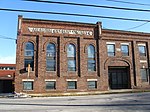Stephen Symmes Jr. House
Arlington, Massachusetts Registered Historic Place stubsGreek Revival houses in MassachusettsHouses in Arlington, MassachusettsHouses on the National Register of Historic Places in Arlington, Massachusetts

The Stephen Symmes Jr. House is a historic house in Arlington, Massachusetts. It is built on land that was held in the Symmes family since 1703, when it was purchased from a Native American. Although it has been claimed to date to 1746, the house was probably built in 1841, and may incorporate parts of an older building within it. The building is one of the finest examples of Greek Revival architecture in Arlington, with a pillared porch on two sides. The house is notable for its association with Stephen Symmes Jr., who bequeathed this property to the town for use as a hospital.
Excerpt from the Wikipedia article Stephen Symmes Jr. House (License: CC BY-SA 3.0, Authors, Images).Stephen Symmes Jr. House
Frost Street,
Geographical coordinates (GPS) Address Nearby Places Show on map
Geographical coordinates (GPS)
| Latitude | Longitude |
|---|---|
| N 42.430277777778 ° | E -71.156388888889 ° |
Address
Frost Street 4
02174
Massachusetts, United States
Open on Google Maps










